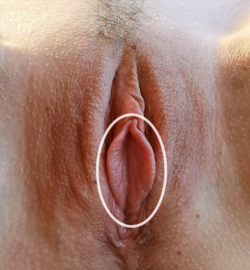Labia minora
are two flaps of skin on either side of the human vaginal opening in the vulva
The labia minora, Latin for smaller lips, singular: labium minus "smaller lip", also known as the inner labia, inner lips, vaginal lips or nymphae,[1] are two flaps of skin on either side of the human vagina. It is an opening in the vulva. It is between the labia majora (the Latin for larger lips; also called outer labia, or outer lips).[2]
| Labia minora | |
|---|---|
 Human hairless vulva with labia minora encircled. The labia minora are the smaller petal-like folds in the very middle of the photo, between the thicker outer labia majora. | |
| Details | |
| Precursor | Urogenital folds |
| Part of | Vulva |
| Identifiers | |
| Latin | labium minus pudendi |
| TA | A09.2.01.007 |
| FMA | 20374 |
| Anatomical terminology | |

The labia minora vary widely in size, color, and shape from individual to individual.

References
change- ↑ nymphae. Dictionary.com. Merriam-Webster's Medical Dictionary. Merriam-Webster, Inc. (accessed: November 24, 2007).
- ↑ "How the female reproductive system works | girlshealth.gov". www.girlshealth.gov. Retrieved 2018-08-13.
- ↑ "Innie vs. outie vagina: What are the differences? Learn more here". www.medicalnewstoday.com. 2021-02-18. Archived from the original on 16 December 2021. Retrieved 2021-12-20.
- ↑ "Do You Have An Outie Vagina Or An Innie Vagina? Here's How To Tell". Women's Health. 2019-04-17. Archived from the original on 4 March 2022. Retrieved 2021-12-20.
- ↑ McDougall, Lindy (2021). The Perfect Vagina : Cosmetic Surgery in the Twenty-First Century. Bloomington: Indiana University Press. ISBN 978-0-253-05612-2. OCLC 1240584800. Archived from the original on 4 March 2022. Retrieved 20 December 2021.